2014—2015学年度第一学期PEP新版六年级英语知识点归纳总结
- 格式:doc
- 大小:86.00 KB
- 文档页数:6
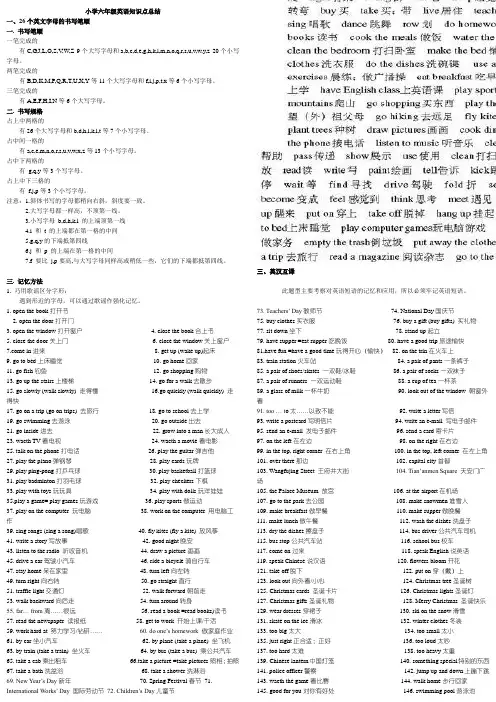
小学六年级英语知识点总结一、26个英文字母的书写笔顺一. 书写笔顺一笔完成的有C,G,J,L,O,S,V,W,Z 9个大写字母和a,b,c,d,e,g,h,k,l,m,n,o,q,r,s,u,v,w,y,z 20个小写字母。
两笔完成的有B,D,K,M,P,Q,R,T,U,X,Y等11个大写字母和f,i,j,p,t,x等6个小写字母。
三笔完成的有A,E,F,H,I,N等6个大写字母。
二. 书写规格占上中两格的有26个大写字母和b,d,h,i,k,l,t等7个小写字母。
占中间一格的有a,c,e,m,n,o,r,s,u,v,w,x,z等13个小写字母。
占中下两格的有g,q,y等3个写字母。
占上中下三格的有f,j,p等3个小写字母。
注意:1.斜体书写的字母都稍向右斜,斜度要一致。
2.大写字母都一样高,不顶第一线。
3.小写字母b,d,h,k,l 的上端顶第一线4.i 和t 的上端都在第一格的中间5.g,q,y的下端抵第四线6.j 和p 的上端在第一格的中间7.f 要比j,p要高,与大写字母同样高或稍低一些,它们的下端都抵第四线。
三. 记忆方法1. 巧用歌谣区分字形:遇到形近的字母,可以通过歌谣作强化记忆。
如:d和b,“一把剪刀分两半,左下圆圈ddd,右下圆圈bbb”;u和n,“开口朝上uuu,开口朝下nnn”;m和n,“一道门儿是n,二道门儿是m”。
2. 巧用歌谣记牢笔顺:“大写字母A, E, F, H,小写字母f和t,最后才把腰带系。
”这句话的意思告诉孩子,字母有中横的,如“A, E, F, H, f, t”等,中间的那横像腰带,要最后写。
“小写字母i和j,出门再戴小帽子。
” 小写字母如“i, j”等,顶上那一点如同小帽子,也要最后写。
3. 巧用熟悉的事物:字母“E”像一座楼房,得先把外墙砌好,才能盖屋顶,所以要先写竖折,再写两横。
字母“F”象旗子。
讲解:“要把F这面旗子插牢,得先把旗杆写正,先写一竖。
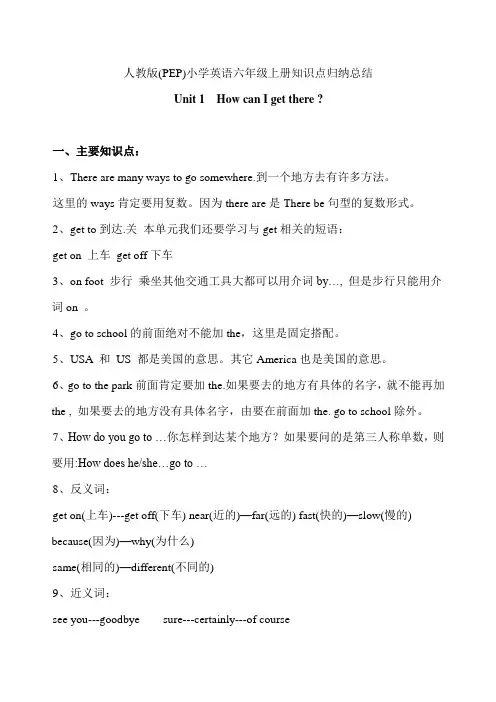
人教版(PEP)小学英语六年级上册知识点归纳总结Unit 1 How can I get there ?一、主要知识点:1、There are many ways to go somewhere.到一个地方去有许多方法。
这里的ways肯定要用复数。
因为there are是There be句型的复数形式。
2、get to到达.关本单元我们还要学习与get相关的短语:get on 上车get off下车3、on foot 步行乘坐其他交通工具大都可以用介词by…, 但是步行只能用介词on 。
4、go to school的前面绝对不能加the,这里是固定搭配。
5、USA 和US 都是美国的意思。
其它America也是美国的意思。
6、go to the park前面肯定要加the.如果要去的地方有具体的名字,就不能再加the , 如果要去的地方没有具体名字,由要在前面加the. go to school除外。
7、How do you go to …你怎样到达某个地方?如果要问的是第三人称单数,则要用:How does he/she…go to …8、反义词:get on(上车)---get off(下车) near(近的)—far(远的) fast(快的)—slow(慢的) because(因为)—why(为什么)same(相同的)—different(不同的)9、近义词:see you---goodbye sure---certainly---of course10、频度副词:always 总是,一直usually 通常often经常sometimes 有时候never 从来不二、主要单词:museum博物馆bookstore书店cinema电影院turn 转弯hospital医院left向左post office 邮局science科学right向右straight笔直地crossing 十字路口三、习惯语搭配:post office邮局science museum科学博物馆pet hospital宠物医院Italian restaurant意大利餐馆Beihai Park北海公园Palace Museum故宫博物院go straight直走turn right/left右/左转next to挨着in front of...在...前面near the park在公园附近on Dongfang Street在东方大街上四、惯用表达式:by plane 坐飞机by ship 坐轮船on foot步行by bike 骑自行车by bus 坐公共汽车by train 坐火车traffic lights交通灯traffic rules交通规则Stop at a red light 红灯停Wait at a yellow light 黄灯等Go at a green light 绿灯行Excuse me 打扰一下Follow me, please!请跟着我!五、主要句子:How do you go to school你怎么去上学?Usually I go to school on foot. Sometimes I go by bus.通常我步行去上学。
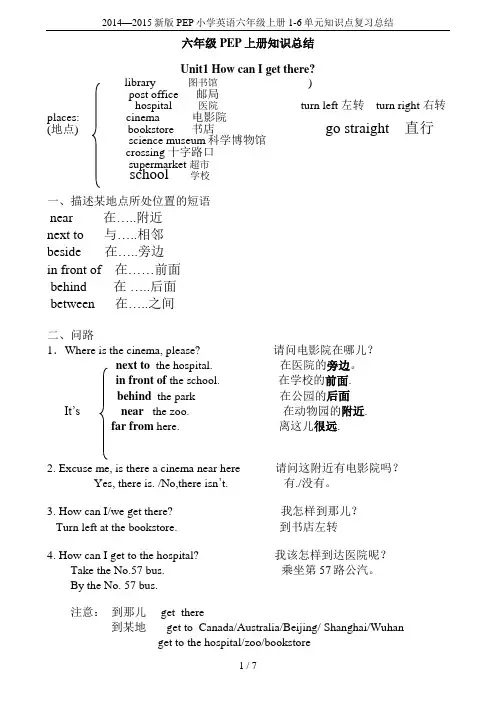
六年级PEP上册知识总结Unit1 How can I get there?library 图书馆 )post office 邮局hospital 医院turn left 左转 turn right 右转places: cinema 电影院(地点) bookstore 书店go straight 直行 science museum科学博物馆crossing 十字路口supermarket 超市school 学校一、描述某地点所处位置的短语near 在…..附近next to 与…..相邻beside 在…..旁边in front of 在……前面behind 在…..后面between 在…..之间二、问路1.Where is the cinema, please? 请问电影院在哪儿?next to the hospital. 在医院的旁边。
in front of the school. 在学校的前面.behind the park 在公园的后面It’s near the zoo. 在动物园的附近.far from here. 离这儿很远.2. Excuse me, is there a cinema near here 请问这附近有电影院吗?Yes, there is. /No,there isn’t. 有./没有。
3. How can I/we get there? 我怎样到那儿?Turn left at the bookstore. 到书店左转4. How can I get to the hospital? 我该怎样到达医院呢?Take the No.57 bus. 乘坐第57路公汽。
By the No. 57 bus.注意:到那儿 get there到某地 get to Canada/Australia/Beijing/ Shanghai/Wuhan get to the hospital/zoo/bookstore二、指引路1. You can take the No.32 bus. 你可乘坐312路公交车去那儿.注意:You can go by the No.32 bus. 与上句意思一样,只是说法不同。
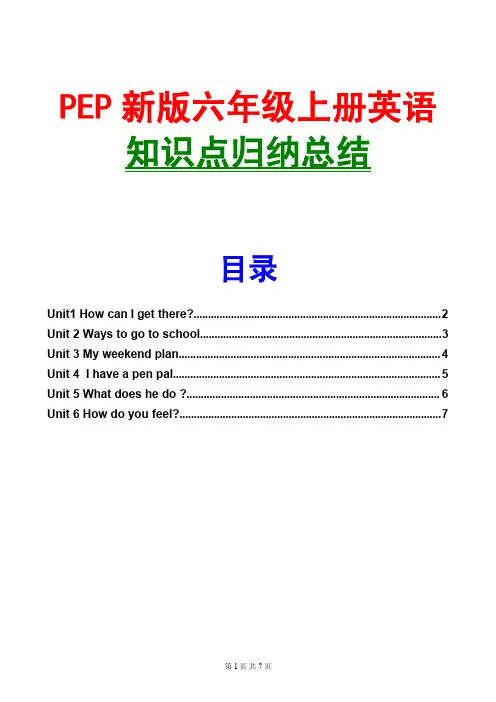
PEP新版六年级上册英语知识点归纳总结目录Unit1How can I get there? (2)Unit2Ways to go to school (3)Unit3My weekend plan (4)Unit4I have a pen pal (5)Unit5What does he do? (6)Unit6How do you feel? (7)Unit1How can I get there?library图书馆north(北)post office邮局hospital医院turn left左转turn right右转places:cinema电影院(地点)bookstore书店(东)east west(西) science museum科学博物馆pet hospital宠物医院crossing十字路口school学校south(南)shoe store/shop鞋店supermarket超市go straight直行一、问路1.Where is the cinema,please?请问电影院在哪儿?next to the hospital.在医院的旁边。
in front of the school.在学校的前面.behind the park在公园的后面It’s near the zoo.在动物园的附近.on the right/left of the bookstore.在书店的左/右边.east of the bank.在银行的东边.far from here.离这儿很远.2.Excuse me,is there a cinema near here请问这附近有电影院吗?Yes,there is./No,there isn’t.有./没有。
3.How can I get to the hospital?我该怎样到达医院呢?Take the No.57bus.乘坐57路公汽。
二、指引路1.You can take the No.312bus.你可乘坐312路公交车去那儿.2.Go straight for three minutes.向前直走3分钟.3.Turn right/left at the…在…地方向右/左转.4.Walk east/west/south/north for…minutes.朝东/西/南/北/走…分钟.三、Is it far from here?离这儿远吗?Yes,it is./No,it isn’t.是的,很远/不是,很远。
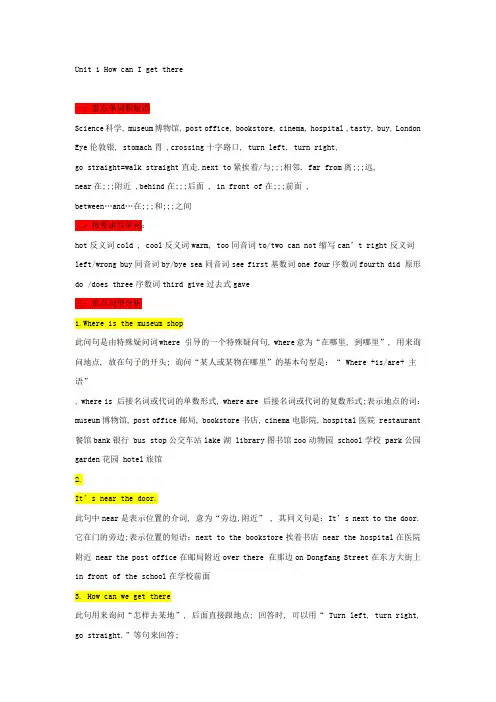
Unit 1 How can I get there一:重点单词和短语Science科学, museum博物馆, post office, bookstore, cinema, hospital ,tasty, buy, London Eye伦敦银, stomach胃 ,crossing十字路口, turn left, turn right,go straight=walk straight直走.next to紧挨着/与;;;相邻, far from离;;;远,near在;;;附近 ,behind在;;;后面 , in front of在;;;前面 ,between…and…在;;;和;;;之间二:按要求写单词:hot反义词cold , cool反义词warm, too同音词to/two can not缩写can’t right反义词left/wrong buy同音词by/bye sea同音词see first基数词one four序数词fourth did 原形do /does three序数词third give过去式gave三:重点句型分析1.Where is the museum shop此问句是由特殊疑问词where 引导的一个特殊疑问句, where意为“在哪里, 到哪里”, 用来询问地点, 放在句子的开头; 询问“某人或某物在哪里”的基本句型是:“ Where +is/are+ 主语”, where is 后接名词或代词的单数形式, where are 后接名词或代词的复数形式;表示地点的词:museum博物馆, post office邮局, bookstore书店, cinema电影院, hospital医院 restaurant 餐馆bank银行 bus stop公交车站lake湖 library图书馆zoo动物园 school学校 park公园garden花园 hotel旅馆2.It’s near the door.此句中near是表示位置的介词, 意为“旁边,附近” , 其同义句是:It’s next to the door.它在门的旁边;表示位置的短语:next to the bookstore挨着书店 near the hospital在医院附近 near the post office在邮局附近over there 在那边on Dongfang Street在东方大街上in front of the school在学校前面3. How can we get there此句用来询问“怎样去某地”, 后面直接跟地点; 回答时, 可以用“ Turn left, turn right, go straight.”等句来回答;同义句:1.Can you tell me the way to+地点2.Where is the +地点3.Which is the way to +地点4.Turn left at the bookstore. Then turn right at the hospital.此句是指路的句型; 常用到的句型有:turn left, 向左转turn right, 向右转go straight直着走;同时表示在某处的介词用at.5.Is the Thames far from hereNo, it isn’t.此句是个be动词开头的一般疑问句, 其回答要用Yes或No. 句中的far from意为“离……远”;反义词组为next to.Unit 2 Ways to go to school一:重点单词和短语on foot步行, by bus =take a bus 乘公交车 by plane,乘飞机 by taxi 乘出租车by ship乘船 by subway 乘地铁by train乘火车 by bike骑自行车by ferry 乘轮渡Hooray好极了slow down 慢下来, stop 停 wait等 pay attention to注意 cross the road 横穿马路 traffic light通信号灯at home在家 missedmiss的过去式想念different,不同chopsticks,筷子复数cross穿过look right向右看 same 相同的door门look at朝;;;看play with和;;;一起玩二:按要求写单词:go 反义词come foot复数feet child复数childrenearly反义词late good反义词bad坏 take带走反义词bring拿来slow反义词quick/fast go 过去式went do过去式 diddo第三人称单数 doesgo第三人称单数 goessame 相同的反义词different不同的miss过去式 missedwrong 错误反义词right正确 can否定形式can’t三:重点句型分析1.How do you come to school你们怎么来学校的此问句是由特殊疑问词how引导的特殊疑问句, 用于询问对方的出行方式; 回答时要根据具体情况作答;表示地点的词:Germany德国 Munich慕尼黑 England英国 Australia澳大利亚school学校 the park 公园the cinema电影院 the hospital医院 the post office邮局the bus stop公共汽车站 home家2.Usually, I come on foot.=Usually, I walk.通常情况下,我步行来;此句是对出行方式的回答句; 其中usually意为“通常”, 表示频率很大, on foot意为“步行”; 一般用by表示出行方式; By后面一定要直接加交通工具的单数形式, 只有“小脚丫”foot与on 搭配, “步行”用on foot表示;3.I must pay attention to the traffic lights.我必须注意交通信号灯; Must是情态动词,意为“必须”后面跟动词原形;动作词组:wear a helmet戴头盔 pay attention to the traffic lights注意交通信号灯look right向右看4.Don’t go at the red light别闯红灯此句是Don’t开头的否定祈使句, don’t后面跟动词原形;意为“不要做某事”;动作词组:run跑 go at the red light闯红灯 touch the door触摸门Eg. Don’t smoke.不要吸烟;/禁止吸烟;Don’t take photos.禁止拍照;5We must look right before crossing the road.我们在横穿马路前必须看看右边;此句中must是情态动词, 意为“必须”后面跟动词原形, 在此句中before是一个介词, 而介词后面跟动词-ing形式;6. There is no door on the bus.公共汽车上没有门;此句是there be句型的单数句, be动词要根据后面名词的单复数形式来决定, 名词为单数或不可数名词就用there is, 名词为复数就用there are. 此句中no door意为“没有门”, 表示单数含义,因此要用there is开头;Unit 3 My weekend plan一:知识点小结重点单词和短语visit拜访film电影 see a film看电影 trip旅游take a trip去旅游supermarket, 超市evening晚上,傍晚 tonight在今晚tomorrow明天next week下周dictionary 字典comic 滑稽的comic book连环画册word book单词本postcard明信片learn 学习teach教disturb打扰 without没有pool池子 jump in跳进 remember记住 lesson 课space太空 travel尤指长途旅游 half一半 price 价格moon月亮make a snowman 堆雪人share sth事 with sb人和某人分享某物lots of= a lot of 许多二:按要求写单词look for 同义词 find leaf 复数 leaves picture 复数 picturessee 同义词 watch/look film 同义词 movie buy 反义词 sellam /is /are 原形 be is /am 复数are this 反义词 thatgoing 原形 go swim 现在进行时swimming can否定形式can’ttoo同音词 two /to clothe复数clothes ice-skate现在进行时ice-skating autumn同义词 fall autumn反义词spring teach 反义词 learn三:重点句型分析1.---What are you going to do tomorrow---I’m going to have an art lesson.此句是个一般将来时态的特殊疑问句; 用了be going to 结构; “be going to +动词原形”构成一般将来时态, 表示计划、安排将要做的事或根据目前推测将要发生的动作, 意为“打算, 将要”;表示时间的单词:evening晚上,傍晚 tonight在今晚tomorrow明天next week 下周this morning今天早晨 this afternoon今天下午 this evening 今天晚上 this weekend 下周末动词短语原形:make a snowman 堆雪人 take a trip去旅游see a film看电影 visit my grandparents 拜访祖父母watch TV看电视learn how to swim学怎样游泳go skating去滑冰row a boat划船go fishing 去钓鱼 go skiing去滑雪 go shopping去购物 make mooncakes做月饼 read a poem读诗eg: I’m going to make a snowman.我打算去堆雪人;We’re going fishing.我们打算去钓鱼;2.We are going to draw some pictures in Renmin Park.此句是be going to 结构的肯定句式; 基本结构为:主语+ be going to +动词原形+表示将来的时间;Some一些,用于肯定句中, 后接可数名词的复数形式或不可数名词, 而在疑问句或否定中表示一些要用any;3---Where are you going---We’re going to the cinema.此句是where 引导的一般将来时态的特殊疑问句, where意为“哪里”, 它是对地点提问的特殊疑问词, 因此回答时要回答一个具体的地点;表示地点的词:school学校 park 公园 cinema电影院 hospital医院 post office邮局 bus stop公共汽车站 home家 supermarket超市museum博物馆, bookstore书店 , restaurant餐馆bank银行lake湖 library图书馆zoo动物园park公园garden花园 hotel旅馆4---When are you going---Next Monday.此句中when意为“什么时候, 何时”, 它引导的疑问句用来对年、月、日等时间进行提问; 如:---When do you go to school in the morning---At 8:00.5---How can you learn to swim without going to a pool此句是由how 引导的特殊疑问句, 询问别人做事的方式、方法; 句中的can 意为“能够”, 是情态动词,后面跟动词原形; “learn to do something,”学习做某件事, 一般表示还没学或还没做的事情,含义将来的意思;第四单元Unit 4 I have a pen pal一、重点单词和短语pen pal笔友hobby爱好 idea主意studies学习第三人称单数 puzzle谜语hiking徒步旅行forest森林 gift礼物 sometimes有时 angry,生气shout大喊 bushy浓密的 have to不得不get … from…,从;;;得到;;;reading books 读书read stories读故事 do kung fu练功夫 play sports 进行体育运动play the pipa 弹琵琶climb mountains爬山 listen to music听音乐 sing English songs 唱英文歌fly kites放风筝 on a farm在一个农场里 write an e mail to 给;;;写封电子邮件 on the playground在运动场上六 live in住在;;;按要求写单词二、按要求写单词have第三人称单数 has do三单形式does do 否定形式don’tdoes 否定形式doesn’t like 三单形式likes he 所有格形式 histalk动词-ing形式 talking hobby三单形式hobbies story三单形式 stories read三单形式 reads live三单形式 lives swim动词-ing形式 swimmingdo动词-ing形式 doing sing动词-ing形式 singing go动词-ing形式 going teach动词-ing形式 teaching also同义词 too play动词-ing形式 playing student复数students dance动词-ing形式dancing write动词-ing形式writing puzzle复数puzzles hike动词-ing形式 hiking learn动词-ing形式learningfriend复数 friends cook三单形式cooks study三单形式 studiesgo 三单形式goes teach三单形式teaches different反义词 samemake三单形式makes talk 三单形式talks love 三单形式lovessleep三单形式 sleeps let三单形式lets sing三单形式 singsdance 三单形式dances sang 原形sing was原形 is/amthrew原形throw looked原形 look did原形do/does true反义词false三、重点句型分析1.问:What are sb’s hobbies 某人的爱好是什么询问某人的爱好答:主语 +like/likes +动词-ing形式+其他; ;;;喜欢;;;此处是对别人的爱好提问及回答的句型,问句中一般hobby要用复数形式, 因为别人的爱好不只一个, 特别注意hobby一词的复数形式变化规则, 变y为i再加-es;答句是一般现在时态的三单人称的句型; 当主语是第三人称单数时, 后面的动词要用它的第三人称单数形式, 同时like意为“喜欢”, 而喜欢做某事2.结构:like + v-ing 即like 后面跟动词的-ing形式Eg: What are Peter’s hobbies He likes reading stories.动词-ing形式:singing唱歌 dancing跳舞 reading stories 读故事playing football踢足球 doing kung fu 练功夫doing word puzzle猜字谜 go hiking 远足 watching TV看电视 drawing pictures 画画listening to music听音乐going fishing 钓鱼3、Does he live in SydneyNo, he doesn’t.此句是助动词does开头的一般疑问句; 其回答要根据助动词和主语来决定;结构为“Does+ 三单人称+ 动词原形”, 肯定回答结构: Yes, 主语+ does, 否定回答结构: No, 主语+ doesn’t. 4、So he doe sn’t like Zac’s music.此句是含有实意动词的否定句, 其结构为:主语+ don’t/ doesn’t+ 动词原形+其他; 当主语是第三人称单数时, 后面的否定助动词要用doesn’t而不是don’t;Unit 5 What does he do 知识点总结一:重点单词和短语factory工厂 worker,工人postman,邮递员businessman商人 police officer警察fisherman 渔民 scientist,科学家pilot飞行员 coach教练job工作, tamer驯服手 dangerous危险farmer农民 honey蜂蜜 stung叮 assistant助手接待员cracker骇客解密高手 nuts果仁think of考虑/有;;;想法go to work去工作 study hard努力学习 stay healthy保持健康 go home 回家 lots of许多 go to the camp去度假营 be good at擅长;;;head teacher校长二:按要求写词语do三单 does work三单 works he主格 his所有格 him宾格she主格 her宾格或所有格 business名词 businessmanfish名词 fisher can 否定形式can’t drive 名词driver teach 名词teacher country复数countries clean名词cleaner write 名词writer sing名词singer dancer 动词dance player 动词 play worker动词 work is否定形式isn’tgo现在分词 going see三单 sees big 反义词smalltall 反义词short thin反义词 fat/strong short 反义词tall/longsea同音词 see lots of =a lot of has 原形havehealthy名词 health life 动词live hard反义词 easy stay三单 stays study 三单studies science名词 scientist university复数 universities those反义词 thesedifferent 反义词same like三单 likes go三单 goes want三单 wants run现在分词 running report 名词reporter use现在分词 using quick 副词quickly they主格 them宾格 their所有格 children 单数child didn’t 否定形式don’t /doesn’t unusal 反义词usual dangerous 反义词safe farm名词 farmer test名词 tester eat 现在分词eating have三单has三:重点句型分析1.What does he doHe’s a businessman.这是一个询问职业的句型, 它的构成是“ What do/ does+某些人+do”, 可以用“某人+ be+a/an+职业名词”来回答; 询问职业还有一个句型是“ What + be+某人”; 如上面的句子还可以说“ What is he ”;表示职业的词:worker工人 postman邮递员businessman商人coach教练police officer警察 fisherman渔民 scientist,科学家pilot飞行员tamer驯服手farmer农民assistant助手接待员teacher老师 cleaner清洁工doctor医生nurse护士 dentist牙医 tailor裁缝 salespersons售货员 pianist钢琴家2 .---Where does he work---He works at sea.当你想询问他人在哪儿工作时, 用“ Where do/ does+ 某些人+ work”这个句型; 我们通常用一个表示地点的介宾短语来回答这个句型; 介宾短语是由介词加上名词或代词构成的;表示地点的介词短语:at a university 在一所大学in a gym在一个体育馆at sea 在海上on a boat在船上 at the zoo在动物园 in a school 在一所学校in a car company在一家汽车公司 in a bank在一家银行3. ---How does he go to work---He goes to work by bike.要询问别人的上班方式, 可以用“ How do/ does+人物+ go to work”句式来询问, 回答时要用到”by+交通工具的单词“或者是on foot;表示交通方式的词: by the No.15 bus乘15路公交车on foot步行,by bus 乘公交车 by plane,乘飞机 by taxi 乘出租车by ship乘船by subway 乘地铁bytrain乘火车 by bike骑自行车by ferry乘轮渡4. What a great job此句是由“what”引导的感叹句:“what”意为“多么”用作定语,修饰名词被强调部分,单数可数名词前要加不定冠词a/an,复数可数名词或不可数名词前不用冠词;这类句子的结构形式是:What+a/an+形容词+名词+主语+谓语+it is. 如:What a clever girl she is多么聪明的姑娘呀Unit6 How do you feel一:重点单词和短语Angry生气afraid害怕 sad伤心worried担心 happy快乐see a doctor看医生wear穿 more,更多deep身 breath呼吸 take a deep breath深呼吸count to ten 数到十popcorn爆米花make,制作wait等check检查planted种植的过去式grow生长或成长a little worried有一点点担心be angry with…与;;;生气be afraid of ;;;害怕;;;domore exercise做更多的运动 wear warm clothes穿暖和的衣服 get some drinks 拿一些饮料 have some popcorn 吃一些爆米花chase the mice追赶老鼠二:按要求写词语First基数词one chase 三单chases mice单数 mouse chase 现在分词chasing these 反义词those these单数 this sad反义词 happy here反义词 there can’t 肯定形式can can’t 完全形式can not don’t完全形式 do not feel 三单feels friends 单数friend suggestions单数 suggestion warm 反义词cool cold 反义词hot clothes单数clothe much 比较级more worry形容词worried sunny名词 sun hears 动词原形hear say 三单says strong反义词thin strong 近义词fat should否定形式shouldn’t picture复数 pictures ant复数 ants tell反义词 retell hungry反义词 full bad 反义词good ill 反义词 healthy making原形 make doing 原形do planted 原形plant plant 动词过去式 planted waiting动词原形 wait三:重点句型分析1.They are afraid of him.此句中be afraid of 意为“ 害怕某人”; 例如: I am afraid of my maths teacher. 我害怕我的数学老师;2.The cat is angry with them.此句中be angry with意为“ 对某人生气”;例如: I broken the cup. My mother is angry with me. 我打碎了杯子; 妈妈对我很生气;3.What’s wrong此句用于询问对方有什么问题或有什么不顺心的事情, 意为:怎么啦出什么事了例如:A: What’s wrong, Jim 吉姆,你怎么啦B: Maybe I am ill. 也许我病了;4.He should see a doctor this morning建议某人应该做某事的句型此句中should 为情态动词,表示“应该,应当”;此句用来给别人提建议;例如:He should work harder. 他应该更加努力;You should help your mother with the housework. 你应该帮你母亲做家务;5. What are you doing此句是现在进行时态的特殊疑问句, 其基本结构为:疑问词+be+主语+其他例如:What is he doing now回答:He is swimming.肯定句结构为:主语+be+动词-ing形式+其他.例如:We are running now。
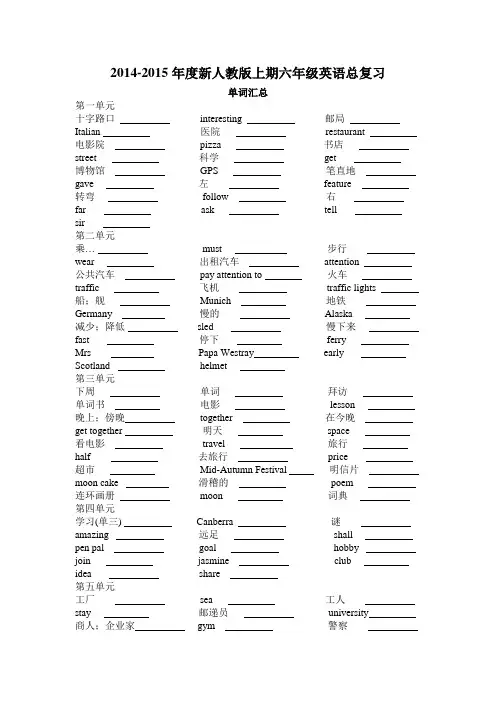
if 渔民reporter 科学家 use 飞行员type 教练quickly country secretary head teacher 第六单元生气的bad 害怕hurt 难过的ill担心的;发愁的wrong 高兴的should 看病feel穿well 更多的sit 深的grass呼吸hear 深深吸一口气ant 数数worry数到十stuck chase mud mice pull everyone重点答语对话1》John: Hello, Mike. Tomorrow is the weekend. ___________.Mike: I’m going to Do nghu Park with my parents.John: ______________Mike: It’s next to Jiankang Hospital.John: ______________Mike: My father is going to drive his car there.John: ______________Mike: We are going to row a boat and fly kites.John: ______________Mike: Yes, look, this is my camera.2》( )1.How do you go to school? A. This afternoon ( )2.Where is the library? B.I`m going to the cinema.( )3.Thank you. C.You`re welcome.( )4.What are you going to do this evening? D.It`s near the post office.( )5.When are you going? E.I go to school on foot.3》A: Excuse me, I'm new here. I want to go to the post office.B: It's near the bookstore.A:B:Yes ,it is .A:B: You can go by the No.302 bus.Get off at the hospital,and then turn left .You can see it.A:I'm going to buy a post card,and send it to my cousin.B:You're welcome.4》A._______________________________?B. I am going to the fruit strand this evening.A._______________________________?B. I am going to buy some grapes.A.______________________________?B. Yes , it’s far. The fruit stand is next tothe pet shop.A.______________________________?B. I can get there by the No.112 bus.thenget offat the pet shop.A. I want to buy a big watermelon. ____?B. Sure .let’s go together.A. Thank you.5》()1. Does Mr Gao often call you? A. Yes, I was.()2. Do you often help your parents? B. Yes, I did.()3. Are you preparing today's lesson? C. No, he doesn't. ()4. Were you in Cuangzhou last month? D. Yes, I do. ()5. Did you finish your English homework? E. Yes, we are. 6》Amy: Excuse me. Where is the post office?Mike: I'm sorry. (1)___________ You can ask the policeman. Amy: Thank you all the same.Amy: (2)_________ Can you tell me the way to the post office? Policeman : (3) __________ You can see the KFC.Amy: And then?Policeman : It's (4)________ to it.Amy: Oh, I see.(5) __________Policeman: (6)___________7》A: ?B:I’m planting peach trees.A: How cool! ___________?B: It’s easy. First, dig thesoil.______. At last, water it.A: Are you going to water it everyday?B: Yes,______ .A: Is peach your favourite fruit?B: __________. But peach is easy to plant.8》( ) Is it a dish? A.I’m from China.( ) Is it a dish or a plate? B.It’s a dish.( )Can you play the piano? C.Three.( )How’s the weather today? D.It’s rainy.( )How many children are there? E.Sure, I can.( )Where are you from? F.Yes, it’s a dish.重点句型变换1.We can go to the park on foot.(改成否定句)2.I am going to see a picture show.(改成一般疑问句)3.My home is far from here. (用Where提问)4.I go to the shop on foot.(用how提问)5.I go to school on foot.(对划线部分提问)6.I’m going to buy an English dictionary.(对画线部分提问)Are you going to ?7.I’m going there this afternoon. (对画线部分提问)are you going ?8.I have magazines.(变为一般疑问句)have magazines?9.当你去商店时,售货员通常首先会说:?10.I’m going to the pet shop tomorrow.(对画线部分提问)are you tomorrow?11.I’m going to clean my room tonight. (对画线部分提问)12.Li Lei brings me a card.(改成一般过去时)__________________________________________________________13.Is your teacher a man? (作肯定回答)___________________________________________________________14.Jenny does her homework at home.(改为一般疑问句)___________________________________________________________15.There are three buses in the bus stop.(对划线部分提问)___________________________________________________________16.It is rainy today.(对划线部分提问)___________________________________________________________重点词填空1》 Different ways go to schoolSome children to school foot in Munich,Germany.In Alaska ,USA,it a lot.Some kids go to school sled .It’s fast.Some children in Jiangxi,China,go to school ferry every day.In Papa Westray ,Scotland ,the children go to school ferry, .But in2009,they (go) to school plane because the ferry didn’t .2》SundayDear Diary,Tomorrow Mid-Autumn Festival.My family going to get together and a big dinner.My aunt going to make mooncakes.My grandma will us a story Chang’e.Robin and I are to read a poem.This is our poem:F is family .We will be together tonight.A is for autumn .It is the autumn .M is for moon .We mooncakes and tell stories about the moon.I is for “I”.I so happy today.L is for love .We Mid-Autumn Festival.Y is for you.You can be together your family too!3》Let’s cook!Do you (like)food?Do you want cook?Join us!Different people in our club (teach)different things.Mandy (talk)about chocolates.Wang Tong (cook)rice and noodles.Cao Jia (make) salad.Who (do) the dishes?Don’t worry .We all (do) them together.We (meet) every Wednesday afternoon 4 o’clock in the dining hall.See you there!4》HuBin sports.He is good football,ping-pong and basketball.He often running school.He to work a gym.Tip:If you sports,you can a coach,a sports reporter,or PE teacher. Sarah likes computers,and she can type very .She wantswork in office.Tip:If you can type quickly,you can be secretary.Robin to be scientist Wu Yifan’s grandfather .He very hard,and he to work in university.Tip:If you like ,you can be scientist.5》 Robin has GPS!Wu Yifan’s grandpa Robin new feature.He now GPS.He can the boys find the Italian restaurant.Robin:We’re the cinema.Let’s straight andturn left the bookstore.Follow ,please.Mike:Is it far?Robin:No.Now we behind the hospital.Let’s right and thenright again.Mike:There the restaurant!Robin:My new GPS !Wu Yifan:Yes!I’ll tell Grandpa.But let’s eat first.I’m hungry!6》Amy _____going to have a busy weekend. _____the morning ,she’s going to _____her mom to do the housework. She is going to _____lunch. _____, she is going to ______her aunt. She will go back home at 5:00. She is going to _____sports_____her mom_____5:30. They will ____a good time.7》My mother is going to have a cookie party in our ____1_____. She is going to __2___ all the mothers and___3__ young children in our street (街道). There are ___4___ five families in our street. And there are eight young children in these families. __5___mother is going to ____6_____some cookies and bring them to the party. But they do not ___7___ to bring any drink. My mother will ___8___ enough(足够) drink. The children will be very __9___, because they can enjoy a lot of ____10___cookies.重点句子博物馆的商店在哪里?它大门附近。
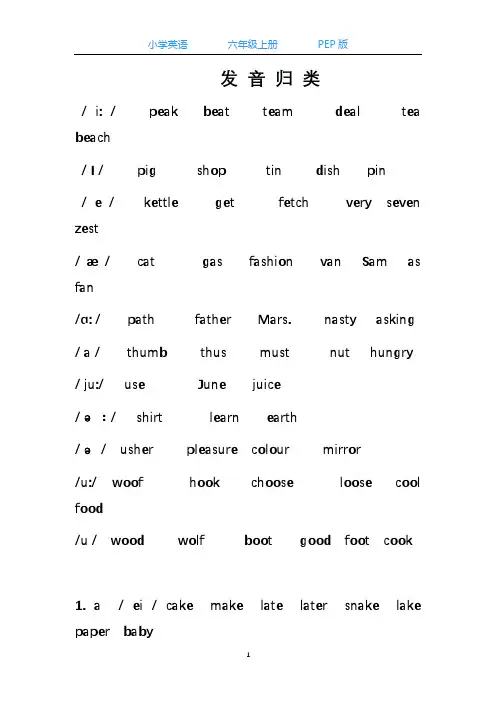
发音归类/ i: / peak beat team deal tea beach/ I / pig shop tin dish pin/ e / kettle get fetch very seven zest/ æ / cat gas fashion van Sam as fan/ɑ: / path father Mars. nasty asking / a / thumb thus must nut hungry / ju:/ use June juice/ ə:/ shirt learn earth/ ə / usher pleasure colour mirror/u:/ woof hook choose loose cool food/u / wood wolf boot good foot cook1. a / ei / cake make late later snake lake paper babya / æ /apple cat cap bag dad hat map black backa /ɑ:/ afternoon after banana dance lastclass glass grass grandma grandpa askfast fathera / ə/ china another woman breakfastaccountant bananaa / ɔ: / water a / ɒ/ watch wash want whata / i / orange2. e / i: / me he she these Chinese we returne / e / leg let bed pen desk yes egg3. i / ai / like kite bike drive time findlibrary excitedi / i / little fish big drink sit milk swimdig sister4. o / əu / Coke nose those close go homeno clotheso / ɒ/ lot dog holiday clock not boxodds hobby pot5. u / ju:/ use student cute excuse duty Tuesdayu / a / usher cut nut but bus cupjump much funnyu / ʊ / putu /u:/ June blue ruler superu / i / busy6. ea / i: / tea eat teacher please ice-creampeach jeans sneakers read meal beansclean season speak leaf leave(s) meaneast teach cleaner stream each sealseat beat wheatea / e / bread breakfast weatherea / ei / great7. ee /i:/ meet green three thirteen jeepqueen canteen sheep sweet beef weekend Halloween tree sleep need week feel seed deep between feet8. ow / au / brown how wow cow flowerdown now town crown shower ow / əu / yellow rainbow window snowy snow snowman know tomorrowrow show grow9. ou / au / mouth mouse out house ourplayground cloudy sour houseworkcloud about mountain southaccountant sprout loudou / u: / group soup coup10. th / ð / the this that these those fathermother brother with grandfathergrandmother clothes they themweather there either then othertogether anotherth / ө/ thank mouth birthday threethirteen thirty fourth eighth ninthtenth eleventh twelfth pathtwentieth thin Thursday healthynorth south month think themethinner thing something bathroom一、辨音,划线部分读音相同的打√,不同的打×(8%)()1. A. teacher B. bread()2. A. train B. wait()3. A. climb B. subway()4. A like B. pig()5. A foot B school()6. A bus B usually( ) 7.A stop B go( ) B plane二、找出划线部分发音不同与其他三个的单词。
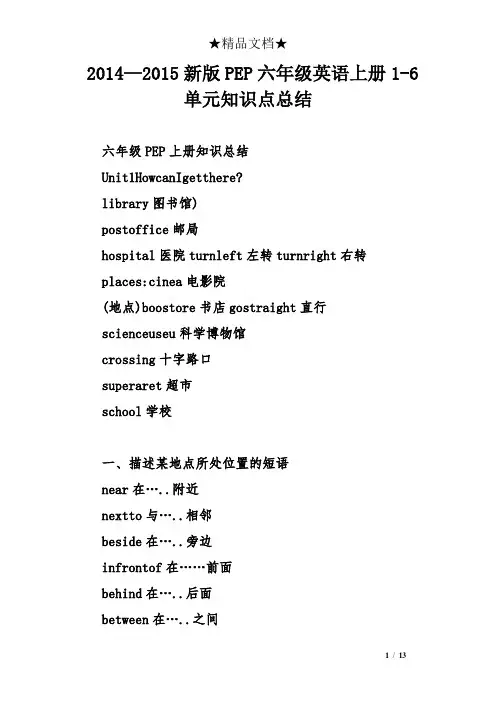
2014—2015新版PEP六年级英语上册1-6单元知识点总结六年级PEP上册知识总结Unit1HowcanIgetthere?library图书馆)postoffice邮局hospital医院turnleft左转turnright右转places:cinea电影院(地点)boostore书店gostraight直行scienceuseu科学博物馆crossing十字路口superaret超市school学校一、描述某地点所处位置的短语near在…..附近nextto与…..相邻beside在…..旁边infrontof在……前面behind在…..后面between在…..之间二、问路1.Whereisthecinea,please?请问电影院在哪儿?nexttothehospital.在医院的旁边。
infrontoftheschool.在学校的前面.behindthepar在公园的后面It’snearthezoo.在动物园的附近.farfrohere.离这儿很远.2.Excusee,isthereacineanearhere请问这附近有电影院吗?yes,thereis./No,thereisn’t.有./没有。
3.HowcanI/wegetthere?我怎样到那儿?Turnleftattheboostore.到书店左转4.HowcanIgettothehospital?我该怎样到达医院呢? TaetheNo.57bus.乘坐第57路公汽。
BytheNo.57bus.注意:到那儿getthere到某地gettocanada/Australia/Beijing/Shanghai/Wuhangettothehospital/zoo/boostore二、指引路1.youcantaetheNo.32bus.你可乘坐312路公交车去那儿.注意:youcangobytheNo.32bus.与上句意思一样,只是说法不同。
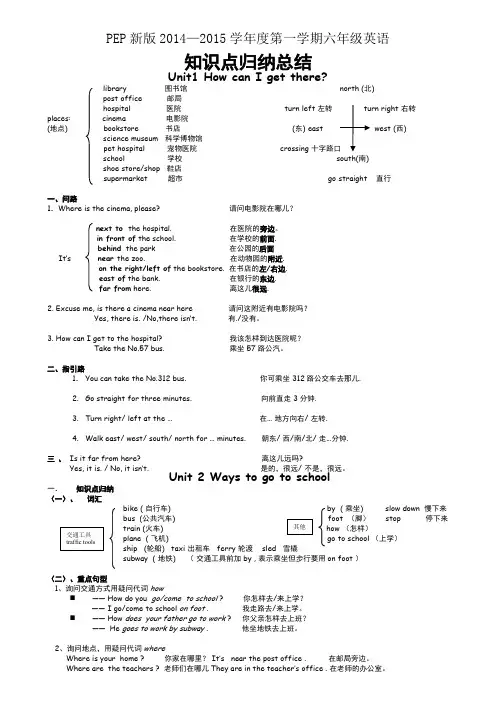
PEP 新版2014—2015学年度第一学期六年级英语知识点归纳总结Unit1 How can I get there?library 图书馆 north (北) post office 邮局 hospital 医院 turn left 左转右转places: cinema 电影院(地点) bookstore 书店 (东西) science museum 科学博物馆 pet hospital 宠物医院 crossing school 学校 south(南) shoe store/shop 鞋店 supermarket 超市 go straight 直行一、问路1.Where is the cinema, please? 请问电影院在哪儿? next to the hospital. 在医院的旁边。
in front of the school. 在学校的前面. behind the park 在公园的后面It’s near the zoo. 在动物园的附近.on the right/left of the bookstore. 在书店的左/右边.east of the bank. 在银行的东边.far from here. 离这儿很远.2. Excuse me, is there a cinema near here 请问这附近有电影院吗?Yes, there is. /No,there isn’t. 有./没有。
3. How can I get to the hospital? 我该怎样到达医院呢?Take the No.57 bus. 乘坐57路公汽。
二、指引路1. You can take the No.312 bus. 你可乘坐312路公交车去那儿.2. Go straight for three minutes. 向前直走3分钟.3. Turn right/ left at the … 在… 地方向右/ 左转.4. Walk east/ west/ south/ north for … minutes. 朝东/ 西/南/北/ 走…分钟.三 、 Is it far from here? 离这儿远吗?Yes, it is. / No, it isn’t. 是的,很远/ 不是,很远。
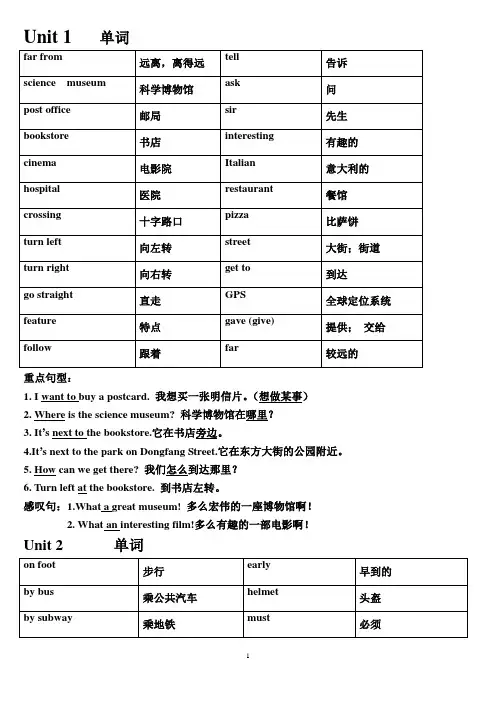
Unit 1 单词重点句型:1. I want to buy a postcard. 我想买一张明信片。
(想做某事)2. Where is the science museum? 科学博物馆在哪里?3. It’s next to the bookstore.它在书店旁边。
4.It’s next to the park on Dongfang Street.它在东方大街的公园附近。
5. How can we get there? 我们怎么到达那里?6. Turn left at the bookstore. 到书店左转。
感叹句:1.What a great museum! 多么宏伟的一座博物馆啊!2. What an interesting film!多么有趣的一部电影啊!Unit 2 单词重点句型:1.How do you come to school?你怎么来的学校?(go to school去学校)2.I come to school by bike.我骑自行车来的学校。
3.How does he go to school?他怎么去的学校?4.He goes to school on foot.他步行去学校。
5.—How do you get to the USA from China?你怎么从中国到美国?—By plane. 乘飞机。
6.Take the No.57 bus over there.乘那里的57路公交车。
7.I must pay attention to the traffic lights.我必须要注意交通信号灯。
8.The park is over there.公园就在那里。
9. In the USA people on bikes must wear the helmet.在美国人们骑自行车必须戴头盔。
10.Don’t go at the red light! 红灯时禁止通行!11.You must look right before you cross the road. 穿过马路时你必须向右看。
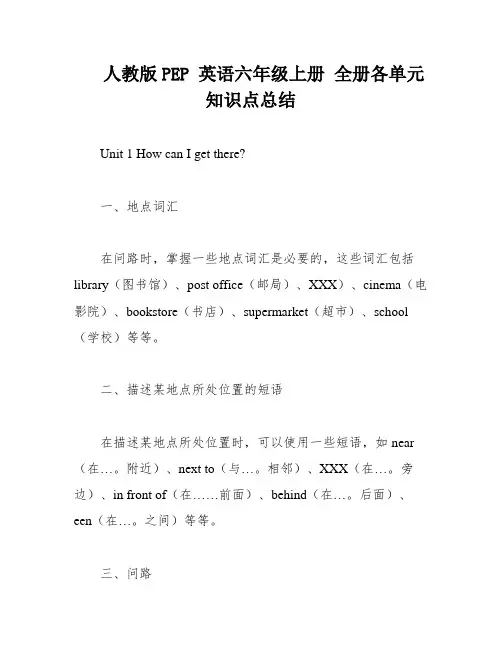
人教版PEP 英语六年级上册全册各单元知识点总结Unit 1 How can I get there?一、地点词汇在问路时,掌握一些地点词汇是必要的,这些词汇包括library(图书馆)、post office(邮局)、XXX)、cinema(电影院)、bookstore(书店)、supermarket(超市)、school (学校)等等。
二、描述某地点所处位置的短语在描述某地点所处位置时,可以使用一些短语,如near (在…。
附近)、next to(与…。
相邻)、XXX(在…。
旁边)、in front of(在……前面)、behind(在…。
后面)、een(在…。
之间)等等。
三、问路当我们不知道某个地方在哪儿时,可以问路。
问路时,我们可以使用一些常用的句型,如“Where is the cinema。
please?”(请问电影院在哪儿?)、“Excuse me。
is there a cinema near here?”(请问这附近有电影院吗?)、“How can I get there?”(我怎样到那儿?)等等。
四、指引路当我们知道了某个地方的位置后,我们需要指引路。
指引路时,我们可以使用一些常用的短语,如“You can take the No.32 bus.”(你可乘坐312路公交车去那儿)、“Go straight and turn left at the bookstore.”(先直行然后在书店那儿左转弯)、“Turn right/ left at the …”(在…地方向右/左转)等等。
Unit 2: Ways to Go to SchoolDo you live far from school。
You may need to choose a XXX method to get there。
Here are some common n tools you can use: bike。
pep英语六年级知识点总结PEP(Primary English Program)是中国人教版小学英语教材的缩写。
它以培养学生的听说读写能力为主要目标,通过生动有趣的教学方式,帮助学生掌握英语基本语音、词汇、语法和交际用语。
下面是PEP英语六年级的知识点总结:一、语音:PEP英语六年级的语音知识点主要包括字母的发音和音标的学习。
六年级学生需要能够准确地读出所有的26个英文字母,并通过练习记住不同字母对应的音标,如/a/表示发音为[æ],/i:/表示发音为[iː]等。
二、词汇:PEP英语六年级的词汇知识点涵盖了基本的日常用词和一些学科词汇。
学生需要熟练掌握数字、颜色、家庭成员、动物、食物、服装等方面的词汇,并能灵活运用于实际生活中。
此外,学生还需要了解一些基本的学科词汇,如科学、地理、历史等,以拓宽词汇量和阅读广度。
三、语法:PEP英语六年级的语法知识点主要包括时态、代词、名词、形容词、副词、介词、连词等。
学生需要掌握一般现在时、一般过去时以及将来时的基本用法,并能运用到口语和书面表达中。
此外,对于名词、形容词和副词,学生需要了解其基本用法和比较级、最高级的构成规则,能够正确使用它们进行句子的完整表达。
四、阅读与写作:PEP英语六年级的阅读和写作能力要求较高。
学生需要通过大量的阅读练习来提高自己的阅读理解能力,掌握阅读技巧,理解文章中的主旨和细节信息。
同时,学生还需要通过写作练习来巩固语法知识、扩大词汇量,提高自己的写作水平。
写作可以包括日记、书信、作文等形式,内容可以涉及自己的生活经历、家庭、学校、旅行等。
五、口语交际:PEP英语六年级注重培养学生的口语交际能力。
学生需要通过与同学、老师以及外教的交流互动来提高自己的口语表达能力。
在口语交际方面,学生需要能够进行简单的自我介绍、问候、提问、阐述观点以及描述事件等,能够用简单的英语与他人进行有效的交流。
六、听力:PEP英语六年级的听力能力是学生全面英语能力的重要组成部分。
pep六年级上册英语知识点汇总六年级上册知识点汇总Unit 1 How do you gl?一、词汇:by plane 坐飞机 by ship 坐轮船步行 by bike 骑自行车by bus 坐公共汽车 by train 坐火车 traffic lights交通灯 traffic rules交通规则gl 去上学 get to 到达 get on上车 get off下车at a red light. 红灯停 Wait at a yellow light. 黄灯等Go at a green light. 绿灯行二、句型:1.How do you gl? 你怎么去上学?ually I glI go by bu通常我步行去上学。
有时候骑自行车去。
How can I get to Zhongshan Park ?我怎么到达中山公园?u can go by the No. 15 bus. 你可以坐15路公共汽车去。
三、语法:1、There are many ways to go somewhere.到一个地方去有许多方法。
这里的ways一定要用复数。
因为there are是Therebe句型的复数形式。
2、步行乘坐其他交通工具大都可以用介词by…, 但是步行只能用介词on 。
4、gl的前面绝对不能加the,这里是固定搭配。
5、USA 和 US 都是美国的意思。
另外America也是美国的意思。
6、gark 前面一定要加the. 如果要去的地方有具体的名字,就不能再加the , 如果要去的地方没有具体名字,都要在前面加the. ( gl除外。
)7、How do you go to …?你怎样到达某个地方?如果要问的是第三人称单数,则要用:How does he/she…go to …?8、反义词:get on(上车)---get off(下车) near(近的)—far(远的) fast(快的)—slow(慢的)because(因为)—why(为什么) same(相同的)—d(不同的)9、近义词:u---goodbye sure---certainly---of cou0、频度副词:always 总是,一直 usually 通常 often经常有时候 never 从来不Unit 2 Wuseum?一、词汇:library 图书馆邮局 hospital医院 cinema 电影院b书店useum科学博物馆 turn left向左转turn right 向右转 go straight 直行 north北south南east东 west西 next to靠近、与…….相邻 then 然后二、句型:1.Wa, please? 请问电影院在哪里?2.It’s nexal. 它与医院相邻。
一. 知识点归纳(一)、 词汇乘坐) (脚)火车(怎样) 飞机(上轮船) ( 地铁) ( 交通工具前加 , 表示乘坐但步行要用 )第五 记住 找到不同 相同的 每个 所有的三会 国家 意思是 驾驶右边的 边 英国 澳大利亚 但是 左边的 如果 必须(二)、重点句型① 询问交通方式用疑问代词⏹ —— ? 你怎样去上学?—— . 我走路去上学。
⏹ —— ? 你怎么去加拿大。
—— . 我坐飞机去。
⏹ —— ? 你父亲怎样去上班?—— . 他坐地铁去上班。
② 询问地点,用疑问代词⏹ —— ? 你家在哪里?—— ’ . 在邮局旁边。
⏹ —— ? 教师们在哪儿?—— ’ . 在教师的办公室。
③ 问路⏹ —— ? 我怎么去中山公园?—— .④ 交通规则( )⏹ ⏹ . 黄灯停 ⏹ . 绿灯行在中国与美国,司机靠右行驶。
但是在英国与澳大利亚,司机靠左边行驶。
词 汇图书馆 (北) 邮局医院: 电影院(地点) 书店 (东) (西)科学博物馆银行学校(南)超市鞋店在哪里请与…相邻右边,正确的左边成直线地然后转弯对不起想要双分钟告诉乘坐远放学以后上车下车第十二聚会;晚会开始买句型一、问路. , ? 请问电影院在哪儿?. 在医院的旁边。
. 在学校的前面.在公园的后面’ . 在动物园的附近.. 在书店的左右边.. 在银行的东边.. 离这儿很远.. , 请问这附近有电影院吗?, . 有.. ? 我该怎样到达医院呢?二、指引路. . 你可乘坐路公交车去那儿.. …在…地方上车下车.. . 向前直走在分钟.. …在…地方向右左转.朝东西南北走…分钟.三 ? 离这儿远吗?一.知识点归纳(一)、词汇四会下周报纸今天上午漫画书今天下午杂志(时间 ) 今天晚上字典今夜明信片明天去旅游主题公园买一些水果宠物店(活动)去看电影(其他)水果摊参观长城鞋店阅读有关植物的杂志商店三会:忙碌的一起地需要其他二、重点句式与句型:本单元中出现的一个重点语法项目是一般将来时:表示将要发生的动作或状态,常与表示将来的时间连用。
新版pep六年级上册英语-各单元知识点总结一:重点单词和短语Science科学, museum博物馆, post office, bookstore, cinema, hospital ,tasty, buy, London Eye伦敦银, stomach胃 ,crossing十字路口, turn left, turn right,go straight=walk straight直走.next to紧挨着/与。
相邻, far from(离。
远), near在。
附近 ,behind(在。
后面) , in front of(在。
前面) , between…and…(在。
和。
之间)二:按要求写单词:hot(反义词)cold , cool(反义词)warm, too(同音词)to/two cannot(缩写)can’t right(反义词)left/wrong buy(同音词)by/bye sea(同音词)see first(基数词)one four(序数词)fourth did (原形)do/does three(序数词)third give(过去式)gave三:重点句型分析1. Where is the museum shop?此问句是由特殊疑问词where 引导的一个特殊疑问句, where意为“在哪里,到哪里”, 用来询问地点, 放在句子的开头。
询问“某人或某物在哪里”的基本句型是:“ Where +is/are+ 主语?”, where is后接名词或代词的单数形式, where are后接名词或代词的复数形式。
表示地点的词:museum博物馆, post office邮局, bookstore书店, cinema电影院, hospital医院 restaurant餐馆bank银行 busstop公交车站lake湖 library图书馆zoo动物园 school学校 park公园 garden花园hotel旅馆2. It’s near the door.此句中near是表示位置的介词, 意为“旁边,附近” , 其同义句是:It’s next to the door.它在门的旁边。
(PEP)小学六年级英语上册知识汇总学生英语学习最明显的效果是爱好教学法,它最符合学生的本质。
通过嬉戏、生动的例子等方法,结合学生的特点采纳不同的教学方法,以激发学生学习英语的欲望,我在这里整理了英语相关学问,欢乐看看吧!(PEP)小学六年级英语上册学问汇总Uni..Ho.d.yo.g.t.school?一、重点短语:b.plan.坐飞.b.shi.坐轮.o.foot步.b.bik.骑自行车b.bu.坐公共汽.b.trai.坐火.trafficlight.交通.traffi.rules交通规那么g.t.schoo.去上.ge.t.到.ge.on上.ge.off下车Sto.a..re.light.红灯.Wai.a..yello.light.黄灯等G.a..gree.light.绿灯行二、重点句型:1.Ho.d.yo.g.t.school?你怎么去上学?uall..g.t.schoo.o.foot.Sometime..g.b.bus.通常我步行去上学。
有时候骑自行车去。
3.Ho.ca..ge.t.Zhongsha.Par.?我怎么到达中山公园?4.Yo.ca.g.b.th.No.1.bus.你可以坐15路公共汽车去。
三、重点语法:1、Ther.ar.man.way.t.g.somewhere.到一个地方去有很多方法。
这里的ways必须要用复数。
因为ther.are是Ther.be句型的复数形式。
2、o.foo.步行。
乘坐其他交通工具大都可以用介词by,但是步行只能用介词o.。
4、g.t.school的前面肯定不能加the,这里是固定搭配。
5、US..U.都是美国的意思。
另外America也是美国的意思。
6、g.t.th.par.前面必须要加the.假如要去的地方有详细的名字,就不能再加th.,假如要去的地方没有详细名字,都要在前面加the..g.t.school除外。
)7、Ho.d.yo.g.to?你怎样到达某个地方?假如要问的是第三人称单数,那么要用:Ho.doe.he/sheg.t.?8、反义词:ge.on(上车)ge.off(下车.near(近的)far(远的.fast(快的)slow(慢的)because(因为)why(为什么.same(一样的)different(不同的)9、近义词:se.yougoodb.esurecertainlyo.course10、频度副词:alway.总是,始.usuall.通.often经常sometime.有时.neve.从来不Uni..Wher.i.th.scienc.museum?一、重点短语:librar.图书.pos.offic.邮.hospital医.cinem.电影院bookstore书.scienc.museum科学博物.turnleft向左转tur.righ.向右.g.straigh.直.north.south南east.west.nex.to靠近、与。
PEP新版2014—2015学年度第一学期六年级英语复习教案Unit1 How can I get there?library 图书馆 north (北)post office 邮局hospital 医院 turn left 左转 turn right 右转places: cinema 电影院(地点) bookstore 书店 (东) east west (西)science museum 科学博物馆pet hospital 宠物医院 crossing 十字路口school 学校 south(南) shoe store/shop 鞋店supermarket 超市 go straight 直行一、问路1.Where is the cinema, please? 请问电影院在哪儿?next to the hospital. 在医院的旁边。
in front of the school. 在学校的前面.behind the park 在公园的后面It’s near the zoo. 在动物园的附近.on the right/left of the bookstore. 在书店的左/右边.east of the bank. 在银行的东边.far from here. 离这儿很远.2. Excuse me, is there a cinema near here 请问这附近有电影院吗?Yes, there is. /No,there isn’t. 有./没有。
3. How can I get to the hospital? 我该怎样到达医院呢?Take the No.57 bus. 乘坐57路公汽。
二、指引路1. You can take the No.312 bus. 你可乘坐312路公交车去那儿.2. Go straight for three minutes. 向前直走3分钟.3. Turn right/ left at t he … 在… 地方向右/ 左转.4. Walk east/ west/ south/ north for … minutes. 朝东/ 西/南/北/ 走…分钟.三、 Is it far from here? 离这儿远吗?Yes, it is. / No, it isn’t. 是的,很远/ 不是,很远。
Unit 2 Ways to go to school一.知识点归纳(一)、词汇bike ( 自行车) by ( 乘坐) slow down 慢下来 bus (公共汽车) foot (脚) stop 停下来 train (火车) how (怎样)plane ( 飞机) go to school (上学)ship (轮船) taxi 出租车 ferry 轮渡 sled 雪橇subway ( 地铁) (交通工具前加by , 表示乘坐但步行要用on foot )(二)、重点句型1、询问交通方式用疑问代词how⏹—— How do you go/come to school ? 你怎样去/来上学?—— I go/come to school on foot . 我走路去/来上学。
⏹—— How does your father go to work ? 你父亲怎样去上班?—— He goes to work by subway . 他坐地铁去上班。
2、询问地点,用疑问代词whereWhere is your home ? 你家在哪里?It’s near the post office . 在邮局旁边。
Where are the teachers ? 老师们在哪儿They are in the teacher’s office .在老师的办公室。
3、问路How can I get to the Fuxing Hospital? 我怎么去福星医院?You can take the No .1 bus . 你可以乘坐1路公汽。
4、交通规则(traffic rules )Stop at a red light . 红灯停Wait and stop at a yellow light . 黄灯停下并等候Go at a green light . 绿灯行In China and the US , drivers(司机) drive(行驶)on the right side of the road . 在中国和美国,司机靠右行驶。
In England and Australia, however(然而), drivers(司机) drive(行驶) on the left side of the road. 但是在英国和澳大利亚,司机靠左边行驶。
Unit 3 My weekend plan一.知识点归纳(一)、词汇next week 下周 newspaper 报纸this morning 今天上午 comic book 漫画书Time this afternoon 今天下午(其他) word book 单词书(时间 ) this evening 今天晚上 dictionary 字典tonight 今夜 tomorrow 明天 post card 明信片take a trip 去旅游 theme park 主题公园activities see a film/watch films 看电影 pet shop 宠物店(活动) go to the supermarket 去超市(其他) supermarket 超市visit my grandparents 拜访祖父母 shoe store 鞋店二、重点句式和句型:本单元中出现的一个重点语法是一般将来时:表示将要发生的动作或状态,常和表示将来的时间连用。
构成:陈述肯定句:主语 + be going to + 动词原形+ 其他否定句:主语 + be + not going to +动词原形+其他一般疑问句: Be+ 主语+ going to +动词原形+其他特殊疑问句:特殊疑问词+ 一般疑问句?例子: I am(not) going to the bookstore by bus this afternoon. 我今天下午打算/(不)打算乘公汽去书店. Are you going to the bookstore by bus this afternoon? 你今天下午打算乘公汽去书店吗?Yes,I am . / No, I’m not. 是的。
/ 不是。
What are you going to do this afternoon? 你今天下午打算干什么?Where are you going this afternoon? 你今天下午打算去哪儿?How are you going to the bookstore this afternoon? 你今天下午打算怎么去?When are you going to the bookstore by bus? 你今天下午打算什么时候去?三、重点句型:1. W e’re going to see a film about space tra vel ! 我们打算去看一场关于火星之旅的电影。
2. Have a good time!玩得开心。
4. ----What are you going to do in the future? 你将来打算干什么?----I’m going to be a science teacher one day. 我想有一天成为一名科学老师。
Unit 4 I have a pen pal一.本单元主要是谈论某人的兴趣爱好。
二.三.语法是动词的-ing形式和动词的第三人称单数形式。
三.词汇: dance (dancing) 跳舞sing (singing ) 唱歌hobby play football (playing football) 踢足球(爱好) read story (reading stories ) 看故事do kung fu (doing kung fu ) 练武术live (lives) 居住,住 like (likes) 喜欢teach (teaches) 教 study ( studies Chinese ) 学习汉语go (goes) 去 go (goes hiking) 去远足第三人单数 watch (watches TV) 看电视read (reads) 读 cook (cooks Chinese food ) 制作中国食物do (does word puzzles ) 猜字谜四.句型:1.询问某人的爱好:----What’s your hobby? 你的爱好是什么?----I like reading stories and singing. 我喜欢读故事和唱歌2. 表示征求别人意见:---- What about you ? /How about you ? /And you ? 你呢?---- Me too. 我也是。
---- Let’s go together. (让)我们一起去吧。
五.语法:一般现在时的用法表示经常或习惯性的动作或状态,常与every day/morning /evening ,often, usually ,always 等状语连用。
如: We do morning exercises every day. 我们每天做晨练。
He usually goes to school by bike. 他通常骑自行车上学。
肯定句:主语+动词+其他。
如: Miss white teaches English. 怀特小姐教英语。
否定句:主语+don’t/doesn’t +动词+其他Miss white doesn’t teach English.怀特小姐不教英语。
一般疑问句:Do/ Does +主语+ 动词原形+其他?如: Does Miss White teach English? 怀特小姐教英语吗?肯否定回答:Yes,she does ./ No, she doesn’t .备注:第一人称单数用does, doesn’t 没有does doesn’t 是动词必须要有变化。
Unit 5 What does he do ?一、知识点归纳(一)词汇singer (歌手) writer ( 作家) Hong Kong ( 香港)head teacher (校长) dancer (舞者) sea (大海)worker ( 工人) cleaner (清洁工 ) factory ( 工厂)postman ( 邮递员) driver (司机) stay / keep ( 保持)businessman ( 商人) secretary (秘书) university (大学)reporter ( 记者) help ( 帮助) fisherman (渔民) money (金钱)scientist ( 科学家) gym ( 体育馆 )police officer /police (警察) use ( 使用) pilot ( 飞行员)football player (足球运动员) type ( 打字 )coach (教练) quickly ( 迅速地)(二)重点句型①询问职业What does he do ?/What is he ? 他是做什么的? He is a doctor. 他是一个医生。